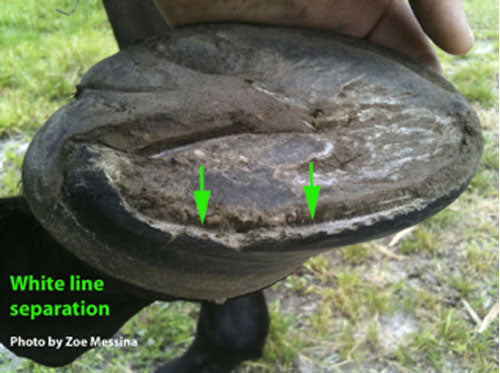Your Cart is Empty
100% REFUND ON TASTE REJECTION

The inner structures of the horse’s hoof are surrounded, supported and protected by what’s known as the ‘hoof capsule’. This is made up of the hoof wall, sole and frog, and is attached to the inner structures and the bone by connective tissue called laminae. The ‘White line’ is the external section of the laminae that can be seen on the bottom of the hoof between the hard wall and softer sole.
In a normal and healthy hoof, the bone inside the hoof capsule, the pedal or coffin bone, (also known as the 3rd phalanx or P3), sits high and has a tight connection via the laminae to the hoof wall (see diagram below). The angle of the front of the pedal bone is parallel with the dorsal (front) hoof wall angle.

The laminae hold the bone and the hoof wall firmly together from the coronet (hairline) to the toe.
The term ‘laminitis’ describes inflammation in the laminae, and this can cause it to weaken, losing its bond with the bone inside the hoof capsule. This creates a loose lamina connection and creates an opportunity for the fungus and bacteria to enter the hoof, leading to Seedy toe or White line disease.
The causes of Laminitis are most commonly related to endocrine and metabolic disturbances, think Insulin resistance and Cushing’s disease. With a large component dietary related, it can also be made much worse in wet and soft footing and when trimming is not optimal.
Laminitis can present as low grade and chronic and the tell-tale sign is a disconnected hoof wall with white line stretching, white line disease, hoof wall flares, cracks, frequent abscessing and seedy toe. All these conditions are caused by a weak lamina connection and cannot really be separated into individual pathologies.
The picture below shows clearly where the white line should be, the arrows show where the white line has separated from the hoof creating a crumbly crack around the inside of the hoof wall.

This obviously creates many issues for the horse, firstly the fungus and bacteria can enter causing havoc and further tissue damage, also it creates a weakness in the hoof wall and destabilises the whole structure.
Dietary mineral balance is extremely important, Zinc and Copper play a massive role here, as does reducing additional forms of Iron in the diet. Also controlling and limiting sugars is very important especially in horses where Insulin resistance is contributing to the breakdown of the hoof walls.
Missy's Bucket is an ideal supplement for horses suffering from Seedy toe and White line disease.
As with Thrush, it’s important to create some dry areas for your horse to hang out in. The hooves need a chance to dry out and if you can include some harder and dryer surfaces to allow this, it can really help. Also, this can assist with conditioning and hardening the hooves as they become accustomed to moving and standing on the harder surfaces. Pea gravel is very useful here, even horses with soft and sore feet will be able to get comfortable on a bed of pea gravel.
It’s very important that the hooves are regularly trimmed and kept in balance. If the hoof walls are allowed to become long, they are subject to massive shearing forces as the horse moves and the walls are literally bent upwards, tearing away from the hoof.
The horse should be encouraged to weight bear on the other structures, the sole and the frog, however, this will be difficult for a horse where these structures in themselves are not healthy.
Weight needs to be taken off the walls to reduce shearing forces and further wall separation. The trimming interval will need to be more frequent, up to 2 weeks apart, until the wall flares are under control. Your trimmer will be able to help you here.
Topical and external treatments can be used, the same hoof soaks used for thrush can be a useful addition to treatment to attack the fungal and bacterial infection directly.
In conclusion, management and treatment of Seedy toe and White line disease needs a holistic approach, addressing the three major contributing factors of diet, environment and trim.
Full recovery can take some time as the hoof will need to ‘Grow In’ a new connection from the coronet band. The hoof grows down from the hairline at a rate of around 8-10mm per month, therefore if the seedy toe is extensive the hoof may need to be managed well for 8-12 months before a whole new hoof capsule, and well-connected lamina is grown from the top down.


